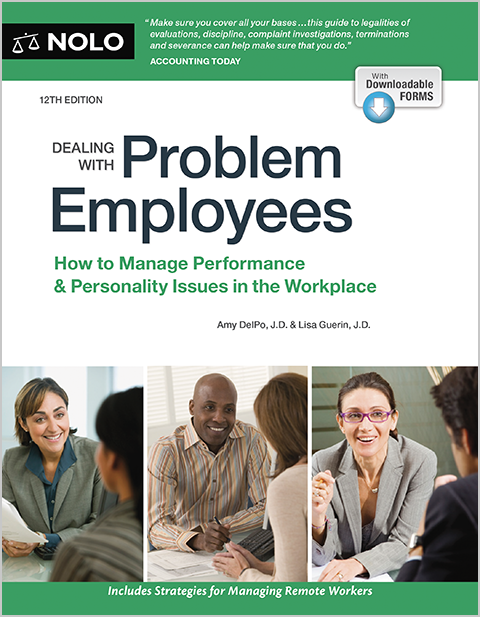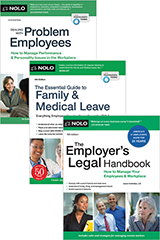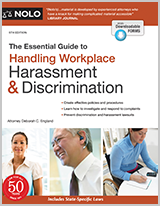Dealing With Problem Employees
How to Manage Performance & Personality Issues in the Workplace
- Product Details
- investigate problems and complaints
- lay the groundwork for termination
- handle severances and references
- prevent discrimination and other types of lawsuits
- avoid hiring problem employees in the future
- stop bullying and harassment, and
- create policies for remote employees.
- Sample Offer Letter Preserving At-Will Employment
- Sample Performance Log
- Sample Performance Evaluation
- Sample Verbal Warning
- Sample Written Warning
- Sample Progressive Discipline Policy
- Sample Company Complaint Policy
- Sample Written Investigation Report
- Employee Performance Log
- Performance Evaluation
- Employee Disciplinary Notice
- Company Complaint Policy
- Termination Risk Assessment
- Checklist of Considerations Before Firing an Employee
- Termination Meeting Checklist
- About the Author
- Table of Contents
- The High Cost of Problem Employees
- How This Book Can Help
- Who Should Use This Book
- Who Should Not Use This Book
- Performance or Productivity Problems
- Interpersonal Problems
- Insubordination
- Excessive Absenteeism
- Drugs and Alcohol
- Theft and Dishonesty
- Violence
- When Technology Is the Problem
- Employment at Will
- Employment Contracts
- Breaches of Good Faith and Fair Dealing
- Violations of Public Policy and Retaliation
- Discrimination
- Unfair Labor Practices
- The Benefits of an Evaluation System
- Step 1: Create Performance Objectives
- Step 2: Observe and Document Employee Performance
- Step 3: Conduct Interim Meetings to Discuss Progress and Problems
- Step 4: Conduct the Year-End Evaluation
- The Benefits of Progressive Discipline
- The Steps of Progressive Discipline
- How Progressive Discipline Works
- Guidelines for Avoiding Legal Trouble
- Sample Progressive Discipline Policy
- When Investigation Is Necessary
- Complaint Policies and Procedures
- Preparing to Investigate
- Conducting Interviews
- Written and Physical Evidence
- Employees’ Rights to Privacy
- Making the Decision
- Types of Alternative Dispute Resolution
- Which Procedures Are Right for Your Company?
- Tips for Creating an Effective ADR Program
- Is It Time to Consider Firing?
- Making the Decision to Fire: An Employer’s Checklist
- Legal Constraints on What You Say
- What to Tell Coworkers
- What to Tell Reference Seekers
- Continuing Health Insurance
- Unemployment Compensation
- Written Explanations of the Termination
- Are You Obligated to Pay Severance?
- Should You Pay Severance?
- Should You Ask for a Release?
- What Should You Offer?
- Preparing a Release
- Agreements to Protect Your Business
- The Termination Meeting
- The Exit Interview
- Improve Your Hiring Process
- Workplace Policies
- When to Hire a Lawyer
- How to Find a Good Lawyer
- Legal Fees
- Working With Your Lawyer
- Firing a Lawyer
- Editing RTFs
- List of Forms
- Federal Agencies That Enforce Workplace Laws
- Federal Fair Employment Laws
- State Laws Prohibiting Discrimination in Employment
- State OSHA Laws and Offices
- Sample Chapter
- An Ohio jury awarded more than $46 million to a former manager at Republic Services, Inc., who claimed he was fired in retaliation for refusing to fire three older employees, which he believed would have been age discrimination. Jurors were particularly upset by evidence that the company tried to prevent the manager from getting another job after he was fired and that the company manufactured evidence of the manager’s poor performance only after the manager sued.
- A California jury awarded $61 million to two drivers for Federal Express, who claimed that they had been harassed and called derogatory names because of their Lebanese heritage. The case later settled (to avoid an appeal by FedEx).
- UBS was ordered to pay more than $29 million to an employee who alleged that she was belittled and denied important accounts because of her sex. UBS also had to pay sanctions for destroying important documents after the plaintiff filed a complaint with the Equal Employment Opportunity Commission (EEOC), and the jury was told to assume that those documents would have hurt the company’s case.
- A jury ordered Metris Companies to pay its former CEO $30 million for wrongful termination. The CEO claimed he was fired because he wanted to tell shareholders that the company was for sale and under investigation by the federal government.
- avoid hiring problem employees in the first place
- effectively deal with specific problems that arise in your workplace
- turn problem employees into productive, valuable workers
- safely and legally terminate employees who can’t or won’t improve
- tap into the potential of every employee
- promote productivity, loyalty, and camaraderie in your workforce, and
- stay out of legal trouble.
- how to decide whether you should fire the employee, including whether you’ve done all you can to protect against lawsuits (Chapter 7)
- how to handle post-termination issues, such as references, unemployment compensation, and continuing health insurance (Chapter 8)
- how to decide whether to offer a severance package (including what to include in the package and whether to ask the employee to sign a release agreeing not to sue you) (Chapter 9), and
- how to legally and safely terminate an employee, step by step (Chapter 10).
- FORMS
Every workplace has occasional problems with employees. This book is packed with the legal and practical information you need to handle all kinds of issues—from small corrective actions to major problems that put your company at risk. It provides proven techniques—and immediate solutions. Find out how to quickly and legally:
The 11th edition is completely updated to reflect the latest employment laws in every state. It provides sample policies, forms, and checklists to help you at every step.
“Offers proven techniques for creating a trouble-free workplace and offers immediate fixes for handling your problem employee of the moment.”—Small Business Opportunities Magazine
“Particularly valuable to startup ventures and small companies that do not have human resource departments.”—Security Management
“Make sure you cover all your bases first…this guide to legalities of evaluations, discipline, complaint investigations, terminations and service can help make sure that you do.”—Accounting Today
Samples
Blank Forms
Introduction
1. What’s Your Problem?
2. Employment Law Basics
3. Performance Evaluations
4. Progressive Discipline
5. Complaints and Investigations
6. Dispute Resolution Programs
7. Making the Decision to Fire
8. Planning for the Aftermath
9. Severance and Releases
10. How to Fire
11. Looking Forward
12. Hiring a Lawyer
Appendixes
A: Using the Downloadable Forms
B: State and Federal Laws
Index
Introduction
Sooner or later it happens to even the most conscientious employers. No matter how carefully they hire workers, how many incentives they give for strong performance, or how diligently they try to create positive and productive work environments, all businesses—large and small—might one day have to deal with a problem employee.
Perhaps you picked up this book because that day has already come for you. Or per- haps an employee has demonstrated attitude or performance problems that won’t go away, has sexually harassed other employees, has stolen from the company, or has threatened violence. Or, you might have picked up this book because you’re concerned about the bigger picture and frustrated with the number of employee problems that crop up year after year. Instead of simply reacting to each problem as it arises, you want to be more proactive. Whether you’re currently facing a specific employee problem or just want guidance about employee problems in general, this book can help. Employee problems are not inevitable, nor must they fill you with fear or anxiety. In the chapters that follow, we provide you with the practical and legal information you need to handle employee problems confidently and to create policies and procedures that will reduce the number and degree of problems you face in the future. As an added bonus, the strategies described in this book will make your workplace more collaborative and will increase employee morale. Everyone in your company will benefit from the healthier workplace these strategies will create.
The High Cost of Problem Employees
For many employers, figuring out whether and how to discipline or fire a worker is one of the most stressful parts of the job. And these concerns are well-founded: Ignoring or mishandling worker problems can be very costly, indeed. Here are some reasons why.
Lawsuits
Wrongful termination and other employment lawsuits brought by current and former employees can be disruptive and expensive. If your company loses one of these lawsuits, it could easily have to pay tens or hundreds of thousands of dollars, even millions, to a successful plaintiff. And that doesn’t even include the cost of paying a lawyer to defend you, win or lose. According to a 2017 report by Hiscox, a business insurance company, the average cost to defend and settle employment discrimination charges that resulted in some payment to the employee was $160,000.
Consider these examples:
| Discrimination Charges Filed With the EEOC |
|---|
| The EEOC collects statistics on how many discrimination charges are filed with the agency each year and what those charges allege. (An employee who wants to sue for discrimination must first file a charge with the EEOC or a similar state agency.) More than 61,000 charges were filed in fiscal year 2021, a historically low number presumably due to the COVID-19 pandemic. In recent years, there have been more charges alleging disability discrimination than any other type; previously, race discrimination charges were more common. However, as has been true for more than a decade, the most frequently filed charge was not for any type of discrimination, but for retaliation. |
Employee Turnover
If you ignore problem employees, handle workplace problems ineffectively, or operate in a draconian manner, you will soon have an employee retention problem. The problem employee will receive neither the guidance nor the opportunity necessary to improve, and will, in all likelihood, be fired or quit. In the meantime, your other employees—who have picked up the slack for that problem worker or, even worse, put up with that worker’s abuse and mistreatment—will soon look for greener pastures.
So, you’ll hire new employees, right? Well, keep in mind that the cost of replacing a worker is much higher than you might imagine. In fact, many experts estimate that it can cost one-and-a-half times a new hire’s salary to replace an employee. The cost of replacing managerial employees can run even higher. And, hiring experts warn that pandemic-related shifts in the labor market are making it tougher than ever to fill empty positions. Wouldn’t it be easier—and less expensive—to hang on to the good employees you already have and help your problem employees turn their performance around?
Poor Workplace Morale
Problem employees can really drag down the spirit of a workplace. As coworkers watch the difficult employee get away with breaking the rules, mistreating others, performing poorly, or being insubordinate, they will feel resentful and unappreciated. They might even feel frightened if the troublemaker poses a threat to their safety or well-being.
If you don’t take action to stop the down- ward spiral, you could face any number of associated problems. You will have trouble recruiting new workers and getting the most out of your remaining employees. You might even find yourself with an epidemic of workers with poor attitudes on your hands. Workers who feel that they are being treated unfairly or taken advantage of are also more likely to resort to small acts of revenge, including theft and fraud.
The Bottom Line
When it comes down to it, problem employees hurt your company’s bottom line. Lawsuits, employee turnover, and low morale cost money and reduce the productivity of your business. All that time problem employees spend harassing coworkers, arguing with you, or “liking” things on Facebook is time spent not working. And all the time other employees spend complaining about a problem worker, taking on the unaccomplished work, and laying bets on when you’ll finally get up the nerve to terminate is likewise lost to the company.
How This Book Can Help
So what can you do about your problem employees? With the help of this book, plenty. We offer you proven strategies for dealing with the most common employment problems, legal information on your rights and responsibilities as an employer, and practical tips that will help you get the job done.
The information we provide will help you:
We start in Chapter 1 by examining the most common types of employee problems and explaining strategies for handling them. In Chapter 2, we explain the basic legal rules that you must keep in mind when making employment decisions. In Chapters 3 through 6, we take an in-depth look at several management practices—performance evaluations, progressive discipline, investigations, and alternative dispute resolution programs— that will prevent many problems from cropping up. When problems do arise, these same practices will enable you to deal with them effectively and legally.
For those situations in which nothing else works, we devote four full chapters to how to fire problem employees. These chapters include information on:
Chapter 11 will help you develop sound hiring and personnel policies to weed out problem employees of the future. In Chapter 12, we explain how to find and select an employment lawyer if you need expert help. Throughout the book, we include tips for managing problems with remote employees, a feature of the pandemic workplace that is clearly here to stay.
Who Should Use This Book
This book is for anyone who oversees employees, including business owners, human resource professionals, supervisors, and managers. If you want to learn about the law, pick up tips and strategies to manage more effectively, and know how to treat your employees fairly, this book is for you. We wrote this book with the conscientious, well-intentioned employer in mind.
Who Should Not Use This Book
This book is not for people who work in the state or federal government. Although many of the strategies that we discuss in this book could be applied to government workers, most employment laws operate slightly differently—or not at all—in the public setting. If you are a manager or supervisor of government employees, this book probably isn’t for you.
This book is also not for people who are looking for ways to “get around” workplace laws. If you are looking for a guide that will show you how to skirt the boundaries of the law, this book won’t help. Our goal is to help well-meaning employers deal with their employment problems legally and effectively, not to help those who wish to evade their legal responsibilities.
We hope you enjoyed this sample. The complete book is available for sale here at Nolo.com.
This Book Comes With a Website
Nolo’s award-winning website has a page dedicated just to this book, where you can:
DOWNLOAD FORMS - All forms in this book are accessible online. After purchase, you can find a link to the URL in Appendix A.
And that’s not all. Nolo.com contains thousands of articles on everyday legal and business issues, plus a plain-English law dictionary, all written by Nolo experts and available for free. You’ll also find more useful books, software, online services, and downloadable forms.
Customers Who Bought This Item Also Bought
How to Manage Performance & Personality Issues in the Workplace



